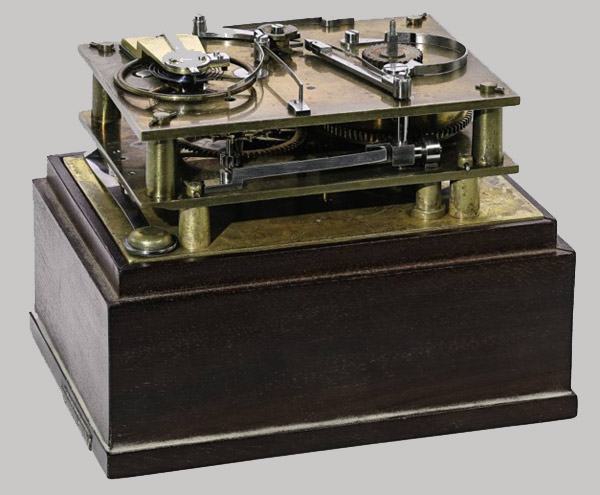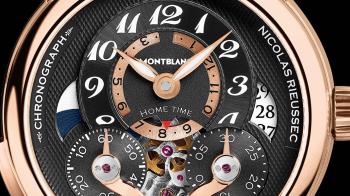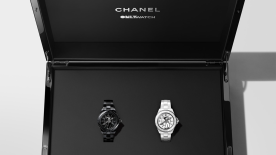1. A contemporary of Breguet and Moinet
Nicolas Mathieu Rieussec was born in Paris in 1781. Very little is known about him, other than the fact that he plied his trade on the Rue du Marché-Palu in Paris. “Palu” in old French means “swamp, marsh”. Incidentally, it’s the origin of the word “paludism”, another term for malaria. The street was in the Cité district, where a certain Abraham-Louis Breguet kept a workshop on the Quai de l’Horloge. The two men probably never worked together. Rieussec invented the chronograph, while Moinet invented the chronometer, and it was on this latter that Breguet chose to focus. Rieussec was later to become Horologer to the King, while Breguet was made Horologer to the Navy.
2. Royal rewards
While Rieussec is known worldwide for the chronograph he invented in 1821, his contribution to clockmaking is less widely acknowledged. And yet clocks constituted the majority of his work, from the time he was appointed clockmaker to the Garde-Meuble de la Couronne, the royal furniture department. He delivered some opulent examples to the Duke of Bordeaux and the Château de Saint-Cloud. His appointment was renewed – he became Clockmaker to the King under Louis XVIII, his brother Charles X and then Louis-Philippe – a rare longevity across different regimes (Restoration and July Monarchy).
3. The rage for racing
The famous Rieussec chronograph was invented in 1821 to time horse races. These days it’s difficult to believe, but at the time the Champ de Mars regularly hosted four races – every day! Because of the sums bet on each race, it became clear that some way of timing them accurately was urgently needed, given the financial stakes for a bourgeoisie obsessed with these equestrian pursuits. Rieussec was the first to understand the importance of precise chronometry. His chronograph was capable of measuring intervals of 1/5th of a second, which was incredible precision for the time.

4. The long history of the chronograph
Like all inventions, Rieussec’s was one of a series of innovations spread over several decades. In 1777, Jean Moïse Pouzait had built a pocket watch with an independent seconds hand that could be stopped, consulted and restarted on demand. There was no reset function, however, and the hour and minute hands continued to rotate while the seconds hand remained immobile! Adolphe Nicole subsequently invented a mechanism for resetting the second hand to 12 o’clock, using a heart-shaped component that is still in use today (patent 10348 of 14/10/1844). Nevertheless, this major horological invention was not implemented until 1862 (by Henri Féréol Piguet, who worked for Nicole & Capt., Adolphe Nicole’s own company). At the same time, Rieussec was working on miniaturising his own device, a pocket chronograph with an inking mechanism to record the time.
5. 2008, Montblanc’s tribute
Montblanc launched the first Nicolas Rieussec Monopusher Chronograph on 7 April 2008 at the SIHH. The “monopusher” label has since been dropped. This very first edition was a limited series of 300: 25 in platinum, 75 in white gold, 75 in yellow gold and 125 in red gold.
6. An ingenious calibre
Throughout its life, the Nicolas Rieussec chronograph has always been fitted with the manufacture calibre MB R X00 (100 or 200), of which there have been a number of variations. While its face is familiar today, we should not forget its two major features. The unusual off-centre counters at 4 and 8 o’clock required a bespoke cam construction to activate the column wheel located at 9 o’clock. Another unique aspect is that the chronograph registers rotate, and the hands are fixed, like Rieussec’s original.

7. From manual to automatic
Not many people know that the first Rieussec was equipped with a manual calibre, the MB R 100. Having said that, an automatic version had been planned from the outset. When it was introduced, under the name MB R 200, a number of adaptations had to be made, including moving the date to 3 o’clock. This is one of the main elements that make an automatic Rieussec immediately distinguishable from a manual. Here’s another interesting fact: in 2010, the MB R 100 was given a silicon escapement. It lasted just one year. The following year, the MB R 200 was introduced, but silicon never came back on the menu. Development of the historic manual calibre MB R 100 ceased, and the movement was retired.
8. What about tomorrow?
In 2011, Montblanc celebrated the 190th anniversary of Rieussec’s invention with an anniversary model, a limited edition of 305 in three different variants. This year, 2018, there has been no anniversary model to celebrate the 10th birthday of the Rieussec collection. The next major development for the range will probably come in 2021, which marks 200 years of Rieussec’s invention, officially recognised by the French Academy of Science as occurring on 15 October 1821. Montblanc have already hinted that they “have some ideas.” Interestingly, however, the patent was not awarded until the following year, on 9 March 1822...





